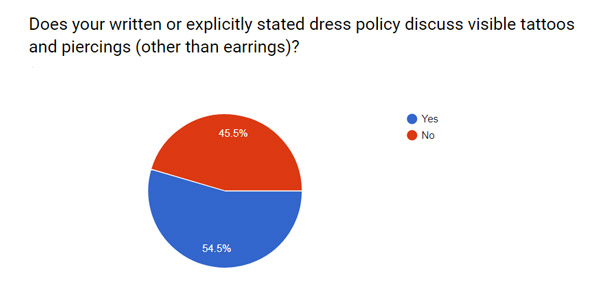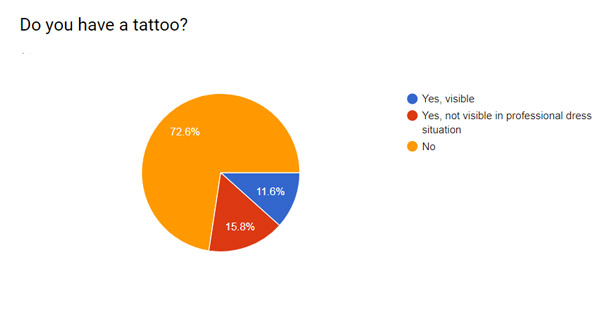Body Art in the Workplace
Women In Optometry poll found that among non-OD women who responded, more than half have tattoos
The majority of practices have a written dress code policy, according to a new Women In Optometry Pop-up Poll. Just more than two-thirds of the respondents said that their office or workplace does have a written policy; 18 percent said they do not and 13 percent said there is no policy “yet.” The remainders have some policies about appearance in the overall company policy or other mechanism for sharing the expectations.


Tattoos and body piercings are mentioned specifically in almost 55 percent of these written policies, while the remaining 45 percent do not address body art and décor specifically. There’s a wide range in what’s acceptable. More than two-thirds of the respondents said pierced ears—regardless of gender—are acceptable. Nose studs and eyebrow piercings are considered allowable in more practices (15 percent) than ear gauges or lip or tongue piercings (10 percent).
Thirty percent of the respondents said that visible tattoos on the hands, arms, legs and feet are OK, and 16 percent said that as long as a tattoo is neither profane nor threatening, it’s probably alright. Sleeves, tattoos that cover much of the arm are allowable, say 12 percent of the respondents, and 8 percent say neck tattoos not covered by hair are allowed. About 5 percent of the respondents wrote that their policy states that tattoos should be discrete and/or covered at work.
Sixty-two percent of the respondents say that if an employee were to get a non-allowed tattoo or piercing, on its own, that would not be a fireable offense; however, it could be a demerit for violating a policy. Seventeen percent said it is cause for dismissal, while 14 percent said it was not. Some respondents wrote in to say that their office culture has become more lax about body art, even though the rule might still be in the dress code. Others note that if there’s not a written policy, it would be difficult to fire an employee on that point alone. Still others wrote in that the employee would have to cover the tattoo or remove a tongue stud, for example, at work.
Overall, 16 percent of the respondents say that they have a tattoo that is not visible during the workday. Another 12 percent have a visible tattoo and 73 percent said they have no tattoo. Among women ODs, 11 percent say they have a visible tattoo, while 10 percent say their tattoo is not visible at work. Eighty-nine percent of women ODs say that they do not have a tattoo. Among male ODs, 10 percent have a tattoo that is not visible at work.


Almost one-quarter of women who are not ODs but work in the optometric profession say that they have a visible tattoo, and 34 percent of them have a tattoo that is covered by work wear. Forty-one percent said they do not have a tattoo.
The plurality of respondents (42 percent) say that their workplace setting is somewhere in the middle on the spectrum between current and traditional. Only 20 percent say their workplace is very or somewhat current, while 28 percent say that their workplace skews toward conservative and traditional, and 10 percent say it’s very conservative.





